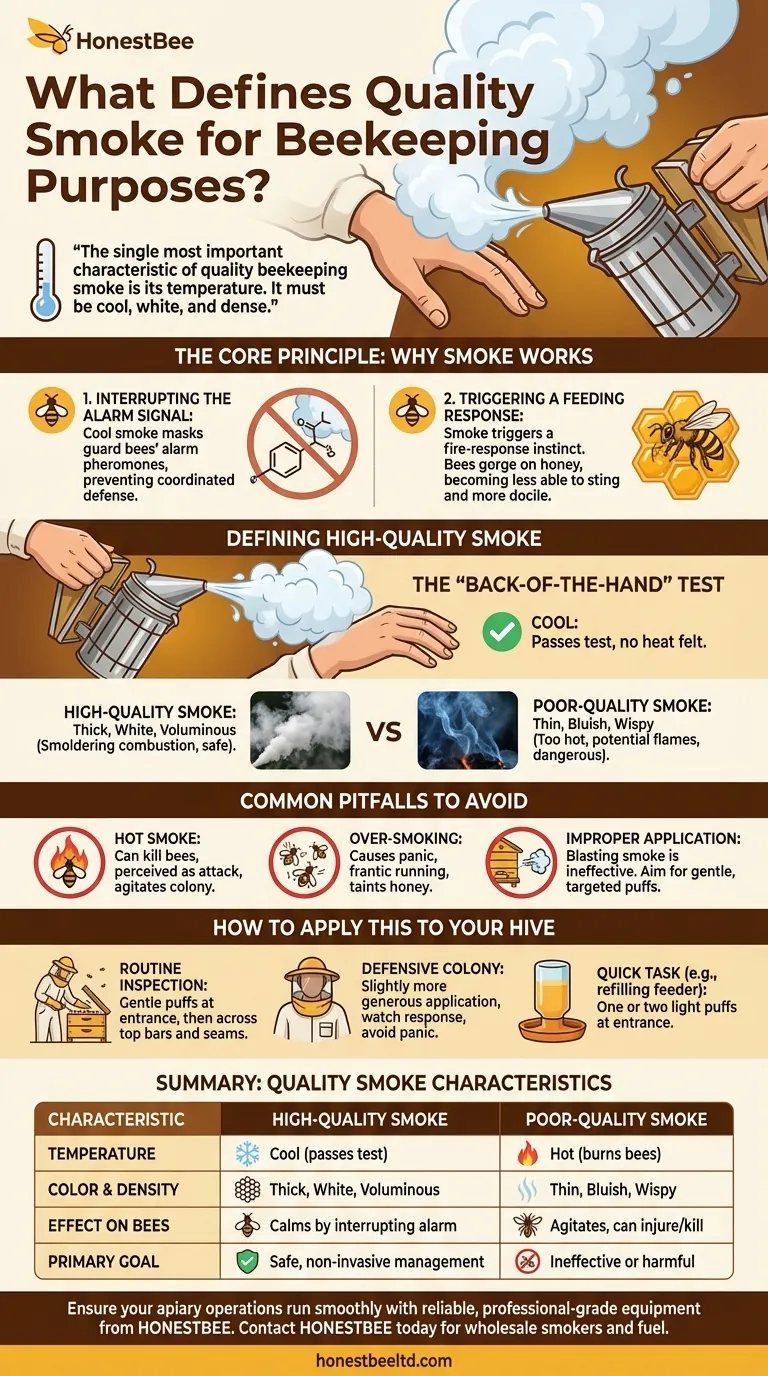The single most important characteristic of quality beekeeping smoke is its temperature. The smoke must be cool, white, and dense. To be considered safe for a hive, it must be cool enough to puff directly onto the back of your bare hand without you feeling any warmth or heat, which could easily burn the delicate wings of a honey bee.
The purpose of using smoke is not to harm or sedate bees, but to temporarily and safely interrupt their chemical alarm signals. Quality smoke achieves this goal calmly, protecting both the colony and the beekeeper from unnecessary stress and harm.

The Core Principle: Why Smoke Works
The use of smoke is a fundamental technique in beekeeping, leveraging the bees' natural instincts to facilitate safe hive inspections. Understanding the "why" behind its effectiveness is key to using it properly.
Interrupting the Alarm Signal
When a hive is disturbed, guard bees release an alarm pheromone to alert the colony to a potential threat. This chemical signal triggers a coordinated defensive response, which we perceive as aggression. Cool smoke effectively masks these pheromones, preventing the alarm from spreading throughout the colony.
Triggering a Feeding Response
Smoke also triggers a secondary, deeper instinct related to fire. Bees sense a potential threat to their home and begin to engorge themselves on honey, preparing to abscond if the hive must be abandoned. A bee with a full stomach is physically less able to flex its abdomen to sting and is generally more docile.
Defining High-Quality Smoke
Not all smoke is created equal. The difference between helpful smoke and harmful smoke comes down to its physical characteristics, which are directly related to your smoker's fuel and management.
The "Back-of-the-Hand" Test
This is the beekeeper's definitive test. Before ever puffing smoke into a hive, puff it onto the back of your hand from a few inches away. If you feel any heat, the smoke is too hot. Hot smoke can scorch wings, injure bees, and will agitate the colony rather than calm it.
Color and Density as Indicators
High-quality smoke is thick, white, and voluminous. This indicates a smoldering, incomplete combustion of your fuel source. In contrast, thin, bluish, or wispy smoke often means your fuel is burning too hot and is on the verge of producing flames, which is dangerous.
Common Pitfalls to Avoid
Using smoke incorrectly can be more detrimental than using no smoke at all. Awareness of common mistakes is crucial for the health of your colony.
Using "Hot Smoke"
This is the most critical error. Hot smoke and embers can kill bees on contact and will be perceived by the colony as a direct, aggressive attack, resulting in a powerful defensive reaction. Always ensure your smoke is cool.
Over-smoking the Hive
More is not better. Too much smoke, even if it's cool, can overly stress the colony, cause bees to run frantically across the comb, and make finding the queen nearly impossible. It can also taint the flavor of honey.
Improper Application
Simply blasting smoke into the hive is ineffective. The goal is a gentle, targeted application. Puffs should be directed where you intend to work to move bees away calmly, not to flood the entire hive cavity with smoke.
How to Apply This to Your Hive
Mastering smoke is a skill that blends technique with observation. Your goal is to work in partnership with the bees, not to dominate them.
- If your primary focus is a routine inspection: Use a few gentle puffs at the entrance before opening, wait a minute, then apply small, targeted puffs across the top bars and down the frame seams as you work.
- If you are dealing with a defensive colony: A slightly more generous application at the entrance may be necessary, but watch their response closely and avoid creating panic.
- If your task is quick, like refilling a feeder: Just one or two light puffs at the entrance is often sufficient to prevent an initial alarm response without disrupting the entire colony.
Mastering the art of quality smoke is the foundation of calm, confident, and compassionate beekeeping.
Summary Table:
| Characteristic | High-Quality Smoke | Poor-Quality Smoke |
|---|---|---|
| Temperature | Cool (passes back-of-hand test) | Hot (can burn bees) |
| Color & Density | Thick, white, and voluminous | Thin, bluish, or wispy |
| Effect on Bees | Calms by interrupting alarm signals | Agitates, can injure or kill |
| Primary Goal | Safe, non-invasive hive management | Ineffective or harmful to the colony |
Ensure your apiary operations run smoothly with reliable, professional-grade equipment from HONESTBEE.
As a trusted wholesale supplier for commercial apiaries and beekeeping equipment distributors, we provide the durable smokers and high-quality fuel you need to produce perfect, cool smoke for every hive inspection. Proper equipment is the first step in protecting your investment and ensuring the well-being of your colonies.
Let's discuss your supply needs. Contact HONESTBEE today to request a wholesale catalog or speak with our team.
Visual Guide

Related Products
- European Stainless Steel Bee Smoker for Honey Bee Hive
- Premium Traditional Copper Bee Smoker with Bellows
- Heavy-Duty Bee Smoker with Durable Plastic Bellows for Beekeeping
- Professional Bee Smoker with Elongated Spout and Durable Bellows for Beekeeping
- Heavy Duty Manual Bee Smoker Blower for Beekeeping
People Also Ask
- What are the differences between stainless steel and galvanized steel bee smokers? Choose the Right Smoker for Your Apiary
- What are the advantages of a high-quality bee smoker? Achieve Calm, Confident Hive Management
- What factors should be considered when choosing a bee smoker? Find the Right Tool for Safe, Effective Hive Management
- What are the features of a recommended bee smoker? A Guide to Safety, Durability & Performance
- How does a smoker help during hive inspections? The Key to Calm, Safe Beekeeping



















